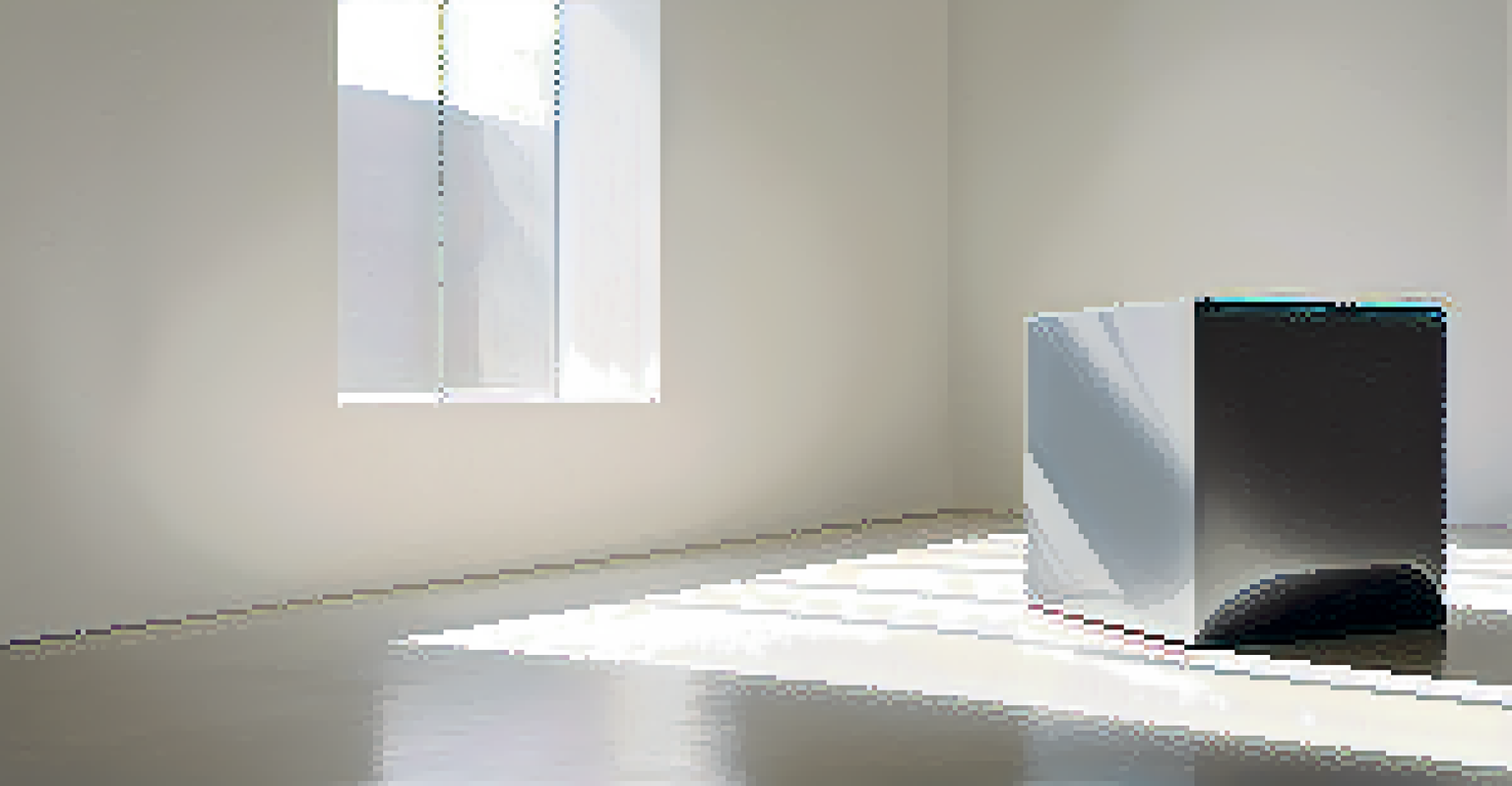The Minimalist Approach: Manifestos of Simplicity in Art

Understanding Minimalism: A Brief Overview
Minimalism emerged as a movement in the late 20th century, emphasizing simplicity and clarity. Artists sought to strip away the unnecessary, focusing on the essence of forms and colors. This approach often challenges traditional artistic norms, inviting viewers to engage in a more profound contemplation of what they see.
Simplicity is the ultimate sophistication.
At its core, minimalism is about reducing art to its fundamental components. It encourages creators and viewers alike to find beauty in simplicity, often leading to a more impactful experience. In essence, less truly can be more when it comes to artistic expression.
The minimalist movement was influenced by various factors, including technological advancements and social changes. Artists began to explore new materials and methods, pushing boundaries while maintaining a focus on simplicity. This evolution paved the way for innovative creations that still resonate today.
Key Manifestos: Principles of Minimalist Art
Manifestos play a crucial role in defining and spreading the principles of minimalist art. One of the most notable is Donald Judd's manifesto, advocating for art that is devoid of emotional expression while emphasizing the object's physical presence. Such declarations help artists articulate their vision and intentions clearly.

Another important manifesto comes from the group known as 'Primary Structures,' which focused on geometric forms and industrial materials. This group showcased how simplicity could be both striking and thought-provoking, paving the way for future minimalist artists. Their collective voices underscored the idea that art should engage with space and viewer perception.
Minimalism: Art of Simplicity
Minimalism emphasizes reducing art to its essential components, inviting deeper engagement and contemplation.
These manifestos not only set guidelines for artists but also challenge audiences to rethink their engagement with art. As viewers, we are invited to strip away preconceived notions and appreciate the raw beauty of minimalist creations. This call to action is a central theme within the minimalist movement.
Influential Minimalist Artists to Know
Several artists have made significant contributions to the minimalist movement, shaping its course and expanding its boundaries. Donald Judd, known for his geometric installations, focused on the interplay between space and form. His works often invite viewers to consider their surroundings in a new light.
The ability to simplify means to eliminate the unnecessary so that the necessary may speak.
Another key figure is Agnes Martin, celebrated for her serene, grid-like paintings. Martin's work embodies the essence of minimalism through subtle color palettes and delicate lines. She believed that art should evoke feelings of tranquility and introspection, illustrating the emotional depth that simplicity can convey.
Finally, we can't overlook the contributions of Dan Flavin, who utilized fluorescent lights to create immersive installations. Flavin's art challenges traditional notions of sculpture and painting, demonstrating how light itself can become a medium for expression. These artists collectively showcase the diverse interpretations of minimalism in art.
The Role of Space in Minimalist Art
Space is a crucial element in minimalism, as it influences how we perceive and interact with art. Minimalist artworks often take into account their surroundings, prompting viewers to engage with both the piece and the space it occupies. This relationship creates a unique experience that goes beyond the artwork itself.
Many minimalist artists intentionally leave negative space within their compositions, allowing the viewer's eye to explore the environment. This use of space invites contemplation and encourages a deeper connection between the audience and the artwork. It’s a reminder that what isn’t there can be just as impactful as what is.
Space Shapes Perception
The role of negative space in minimalist art enhances viewer interaction, creating a unique experience that transcends the artwork.
This emphasis on space also reflects broader themes of simplicity and clarity in life. Just as minimalist art prompts us to appreciate the empty spaces, we can apply this perspective to our own lives, seeking simplicity amidst chaos. In this way, minimalist art serves as a powerful metaphor for living thoughtfully.
Minimalism's Influence on Contemporary Art
The minimalist movement has left a lasting mark on contemporary art, inspiring countless artists across various mediums. Many today still draw from minimalist principles, using simplicity to convey powerful messages. This legacy demonstrates the enduring relevance of the minimalist approach.
Artists like Yayoi Kusama and Ellsworth Kelly incorporate minimalist elements into their work while exploring new themes and ideas. For instance, Kusama’s polka dots and immersive installations push the boundaries of minimalism, blending it with personal narrative and experience. This shows how minimalism can evolve while retaining its core essence.
Furthermore, contemporary art often embraces minimalism as a response to the complexities of modern life. In a world saturated with information and stimuli, the allure of simplicity provides a refreshing respite. As artists continue to explore minimalism, we can expect to see innovative interpretations that resonate with today’s audience.
The Emotional Impact of Minimalist Art
While minimalism is often associated with simplicity, it can evoke profound emotional responses. The stripped-down nature of minimalist art allows viewers to focus on their feelings and thoughts, creating a unique introspective experience. In many ways, the emptiness invites viewers to fill it with their own interpretations and emotions.
For instance, the serene lines of Agnes Martin's paintings might evoke feelings of calmness, while Donald Judd's geometric forms could inspire contemplation about order and chaos. Each viewer brings their own experiences to the artwork, making the emotional impact of minimalism deeply personal.
Minimalism in Daily Life
Embracing minimalist principles in everyday life fosters intentionality and clarity, enriching our focus on what truly matters.
This emotional depth is what sets minimalist art apart from other movements. It encourages a dialogue between the artwork and the viewer, sparking reflections on existence, simplicity, and the human experience. In a world that often feels overwhelming, minimalist art serves as a reminder that beauty can be found in quiet moments.
Embracing Minimalism in Everyday Life
The principles of minimalism extend beyond the realm of art and into everyday life. Embracing simplicity can lead to a more fulfilling and intentional existence. By cutting away the excess, we can focus on what truly matters, whether that’s relationships, hobbies, or personal well-being.
Incorporating minimalist practices might involve decluttering our physical spaces, but it can also mean simplifying our mental and emotional landscapes. Just as minimalist artists provoke thought through simplicity, we can foster clarity and peace by minimizing distractions in our lives. This process encourages mindfulness and a deeper appreciation for the present moment.

Ultimately, the minimalist approach invites us to reflect on our values and priorities. By adopting these principles, we not only enhance our own lives but also cultivate a broader appreciation for the art of simplicity in all its forms. This journey towards minimalism can be both transformative and liberating.